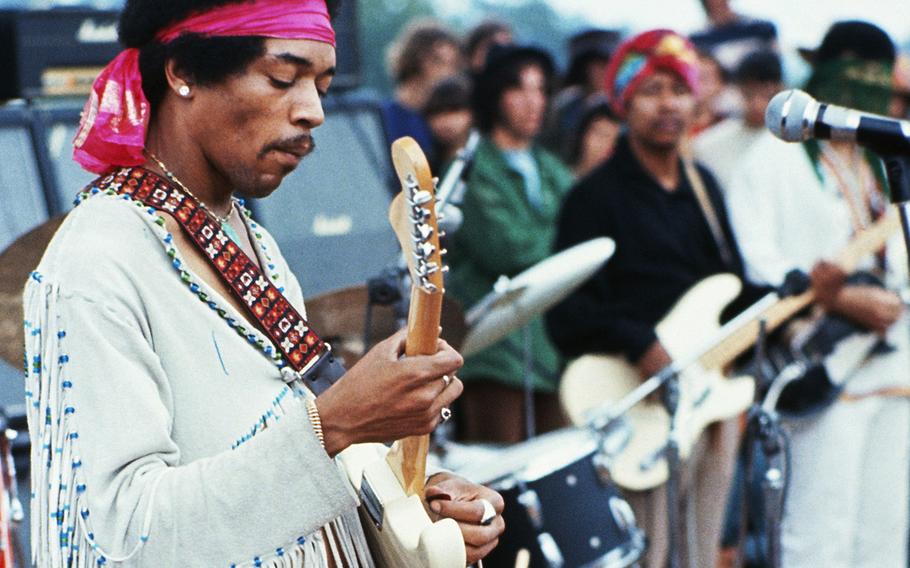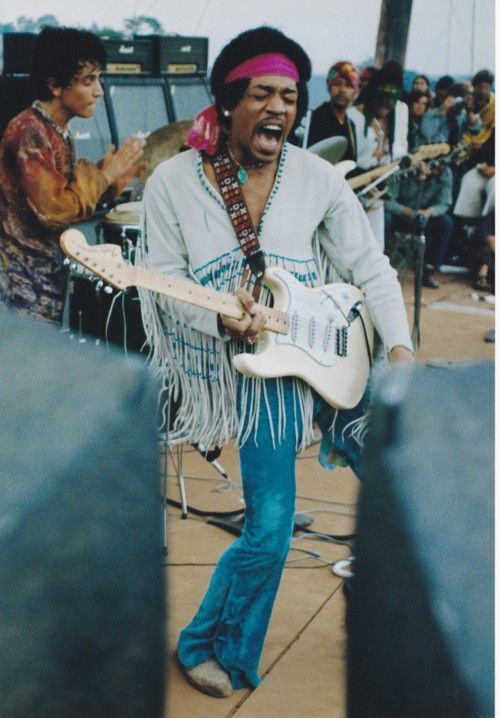The Story of Jimi Hendrix at Woodstock

There is much to say about the infamous Woodstock Festival, which took place August 15th – 18th, 1969 at Max Yasgur’s farm in Bethel, NY.
The festival forever changed the landscape of American music, spawning many copycat events in the years following, and of course laying the blueprint for modern music festivals as we know them.
There were many notable performances from the weekend, and of course some disastrous ones (we’re looking at you, Grateful Dead), but perhaps the most memorable and often-cited came at the very end of the event: Jimi Hendrix and his weekend-closing performance.
Jimi Hendrix took the stage around 8:30am on Monday morning and lasted until around 10:30am, with an encore performance of “Hey Joe” to cap things off.
Although Jimi Hendrix at Woodstock is widely regarded as one of the best rock & roll performances of all time, attendance for the set was quite low compared to peak numbers for the weekend.
At its high point, there were more than half a million people at Woodstock. But weather and other chaotic issues had the crowd down to about forty thousand by the time Hendrix took the stage.
Booking Jimi Hendrix
According to Woodstock co-creator Michael Lang in his 2009 memoir The Road To Woodstock, he had booked Hendrix for two sets, the first one being a surprise acoustic set to kick things off on Friday afternoon.
When the time came to get somebody on stage, Hendrix still hadn’t showed up, and so Lang shuffled Richie Havens onto the stage to kick things off instead.
Hendrix finally showed up around noon on Sunday, and when he arrived he and his manager Michael Jeffrey met with Lang backstage.
The initial plan was for have Hendrix close out the festival at midnight, but at this point there had been multiple delays. If Hendrix were to play at midnight, he would not have been the final performer.
Lang offered Hendrix the midnight slot anyways, but Jeffrey turned it down and said that no matter what, Hendrix would close out Woodstock.

Closing Out Woodstock
So, on that Monday morning at 8:30, Jimi Hendrix and his band claimed the Woodstock stage. The festival announcer Chip Monck introduced them as the Jimi Hendrix Experience.
Jimi was quick to correct him, and noted instead that “We got tired of the Experience and every once in a while we were blowing our minds too much, so we decided to change the whole thing around and call it Gypsy Sun and Rainbows…”
The Woodstock Band: Gypsy Sun and Rainbows
Gypsy Sun and Rainbows was a temporary band put together by Hendrix after the breakup of the Jimi Hendrix Experience earlier that summer, and it consisted of Billy Cox on bass, Juma Sultan and Gerry Velez on percussion, Larry Lee on rhythm guitar, and Mitch Mitchell on drums.
Woodstock was the first of only four performances by Gypsy Sun and Rainbows, as the band only existed for one month.
Equipped with the iconic white Fender Stratocaster, better remembered as the Woodstock Stratocaster, Hendrix and his band opened their set with “Message To Love”, an unreleased track that would later appear on the 1970 live album Band of Gypsys.
The band had apparently been practicing together for several weeks at the nearby house that Jimi had been living in, and they had developed a set suited to jamming and improvisation.
They played long and drawn-out renditions of both the hits and some new material, and Hendrix even traded off lead vocals with Larry Lee for their take on Curtis Mayfield’s “Gypsy Woman”, as well as “Master Mind”.
Playing the National Anthem
The peak moment of Jimi Hendrix’s performance at Woodstock, however, came during his powerful interpretation of “The Star-Spangled Banner”.
It started out innocently enough, as he eased into a fuzzed-out strumming of the chords, but around one minute in Hendrix began improvising literal sounds of “bombs bursting in air” and machine guns with his guitar.
Given the time period when it was performed, during the height of the Vietnam War, many have taken this performance as an anti-war protest from Hendrix, and it fit right in with the countercultural nature of Woodstock.

Hendrix ran strong out of “The Star-Spangled Banner” into his smash hit “Purple Haze”, and then kept going with the improvisation right into the slow, bluesy “Villanova Junction” jam. After that, Hendrix muttered a simple “Thank you”, and walked off the stage.
Interestingly enough, Woodstock was not the first time that Hendrix had played the National Anthem, nor would it be the last.
He had performed the song 28 times prior to his performance at Woodstock, and by the end of his career that number would total over 50, however nothing could possibly top the Woodstock version.
The entire Jimi Hendrix Woodstock performance used to be available on Youtube, but now most of it has been taken down.
Luckily, his famous performance of “The Star Spangled Banner” is still going strong. Corporate America can’t take that one away from us.
Jimi Hendrix – “The Star Spangled Banner” (Live at Woodstock 1969)
It didn’t stop there, however, as although Hendrix rarely played encores, he returned to the stage a few minutes later to rip a blasting “Hey Joe” to really send off the Woodstock patrons who were still standing after three sleepless days and nights.
By 10:30am, it was all over, but that performance has been etched into the American pop-cultural landscape ever since.
Jimi Hendrix – Live at Woodstock (Full Performance)
I was able to find a source on Reddit for Hendrix’s full performance.
It has been up for multiple years now with no issues, but there is no telling how long it will last. Either way, you can watch that below.
Update: As of October 2023, the stream is still available!
How Much Was Jimi Hendrix Paid at Woodstock?
When Lang was booking the Woodstock lineup in June of 1969, he knew he wanted Hendrix to headline the event, and he already had a connection with Jimi after he had headlined Lang’s Miami Pop Festival in May of 1968.
That’s a story for another day, but the long and short of it was that the Jimi Hendrix Experience had played the Miami Pop Festival for $5000, and now just one year later, Hendrix had seriously blown up. He and his band had just gotten paid $150,000 for a show at Madison Square Garden.
Still, though, Hendrix made it clear that he was interested in playing Woodstock, as he had rented a house nearby in West Shokan and he spent some time showing up in the local scene. Lang decided to press on, but could only manage to talk Michael Jeffrey down to $50,000.
Lang’s budget was a hard $15,000, and he couldn’t go over that no matter what. But since Hendrix wanted to play, he was able to get Jimi’s booking agent Ron Terry to agree upon two sets for $15,000 a piece, for a total of $30,000 (hence the planned surprise acoustic set).
This kept Lang within his budget and also satisfied Michael Jeffrey’s hidden desire to have Jimi Hendrix be the highest paid artist on the lineup — which he was.
Since Hendrix never showed up for the acoustic set, the total amount he ended up being paid was somewhere around $15,000 – $18,000.
Jimi Hendrix Woodstock Setlist
“Message To The Universe (Message To Love)”
“Getting My Heart Back Together Again”
“Spanish Castle Magic”
“Red House”
“Master Mind” (feat. Larry Lee)
“Lover Man” (feat. Larry Lee)
“Foxy Lady”
“Jam Back At The House (Beginning)”
“Izabella”
“Gypsy Woman” > “Aware Of Love”
“Fire”
“Voodoo Child (Slight Return)” > “Stepping Stone”
“Star-Spangled Banner”
“Purple Haze”
“Woodstock Improvisation” > “Villanova Junction”
Encore:
“Hey Joe”